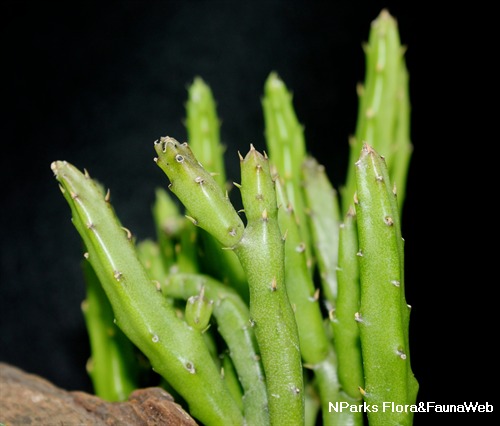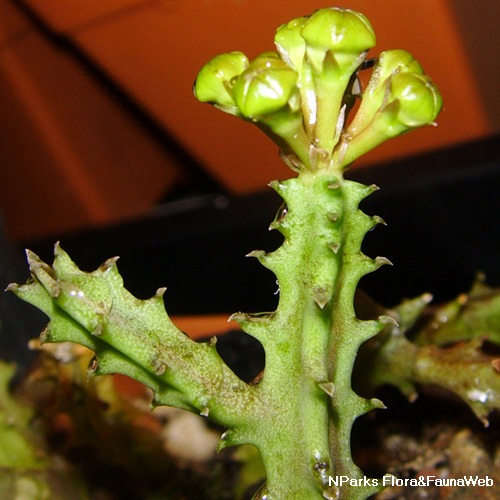
Back
Caralluma fimbriata Wall.
| Family Name: | Apocynaceae |
| Synonyms: | Caralluma adscendens var. fimbriata (Wall.) Gravely & Mayur. |
| Common Name: | Caralluma |
Name
Classifications and Characteristics
| Plant Division | Angiosperms (Flowering Seed Plants) (Dicotyledon) |
|---|---|
| Plant Growth Form | Herbaceous Plant, Succulent Plant |
| Lifespan (in Singapore) | Perennial |
| Mode of Nutrition | Autotrophic |
| Maximum Height | 20 cm to 30 cm |
Biogeography
| Native Distribution | India, Myanmar, Sri Lanka |
|---|
Description and Ethnobotany
| Growth Form | Succulent herb up to 30 cm tall. |
|---|---|
| Foliage | Tiny leaves are produced on young shoots, but quickly drop. |
| Stems | Four-sided, fleshy stems lack leaves. |
| Flowers | Fleshy, purple and yellow flower is star-shaped. It occurs solitary or in small groups of 2-3 flowers. |
| Fruit | Cylindrical fruit occurs in pairs where one fruit is less developed than the other. |
| Ethnobotanical Uses | Food (Fruit or Vegetable): In India, the plant is boiled, seasoned with salt and chili and eaten as a vegetable or added to chutney and pickles. The immature green fruit is also consumed. |
Landscaping Features
| Desirable Plant Features | Ornamental Flowers, Ornamental Form |
|---|---|
| Landscape Uses | Interiorscape/ Indoor Plant, Container Planting |
| Thematic Landscaping | Economic Garden, Rockery / Desert Garden |
Plant Care and Propagation
| Light Preference | Full Sun, Semi-Shade |
|---|---|
| Water Preference | Little Water |
| Rootzone Tolerance | Drought Tolerant, Well-Drained Soils |
Floral (Angiosperm)
| Flower & Plant Sexuality | Bisexual Flowers |
| Flower Colour(s) | Purple, Yellow / Golden, Patterned |
|---|---|
| Flower Texture(s) | Thick / Fleshy, Hairy / Hirsute |
| Flower Grouping | Solitary, Cluster / Inflorescence |
| Flower Location | Cauliflorous |
| Flower Symmetry | Radial |
| Individual Flower Shape | Stellate / Star-shaped |
| Flower Size | 2 cm |
Image Repository
Others
| Master ID | 32420 |
|---|---|
| Species ID | 6831 |
| Flora Disclaimer | The information in this website has been compiled from reliable sources, such as reference works on medicinal plants. It is not a substitute for medical advice or treatment and NParks does not purport to provide any medical advice. Readers should always consult his/her physician before using or consuming a plant for medicinal purposes. |

